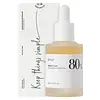What's inside
What's inside
 Key Ingredients
Key Ingredients

 Benefits
Benefits

 Concerns
Concerns

No concerns
 Ingredients Side-by-side
Ingredients Side-by-side

Water
Skin ConditioningGlycerin
HumectantMethylpropanediol
SolventTrehalose
HumectantBetaine
HumectantAllantoin
Skin ConditioningLonicera Japonica Flower Extract
Skin ConditioningMelaleuca Alternifolia Leaf Extract
PerfumingSalvia Officinalis Leaf Extract
CleansingCamellia Japonica Flower Extract
EmollientSodium Hyaluronate
HumectantHydrolyzed Hyaluronic Acid
HumectantHydroxypropyltrimonium Hyaluronate
Sodium Hyaluronate Crosspolymer
HumectantSodium Acetylated Hyaluronate
HumectantAcetyl Hexapeptide-8
HumectantPalmitoyl Tripeptide-5
Skin ConditioningMadecassoside
AntioxidantMadecassic Acid
Skin ConditioningAsiaticoside
AntioxidantAsiatic Acid
Skin ConditioningCentella Asiatica Extract
CleansingCentella Asiatica Leaf Extract
Skin ConditioningCeramide NP
Skin ConditioningDipotassium Glycyrrhizate
HumectantArginine
MaskingLecithin
EmollientCitric Acid
BufferingGluconolactone
Skin ConditioningButylene Glycol
HumectantCaprylyl Glycol
EmollientHydroxyacetophenone
AntioxidantPentylene Glycol
Skin ConditioningDipropylene Glycol
HumectantCaprylic/Capric Triglyceride
MaskingEthylhexyl Palmitate
EmollientCetyl Ethylhexanoate
EmollientPolyglyceryl-10 Myristate
Skin ConditioningAcrylates/C10-30 Alkyl Acrylate Crosspolymer
Emulsion StabilisingTromethamine
BufferingXanthan Gum
EmulsifyingDisodium EDTA
1,2-Hexanediol
Skin ConditioningWater, Glycerin, Methylpropanediol, Trehalose, Betaine, Allantoin, Lonicera Japonica Flower Extract, Melaleuca Alternifolia Leaf Extract, Salvia Officinalis Leaf Extract, Camellia Japonica Flower Extract, Sodium Hyaluronate, Hydrolyzed Hyaluronic Acid, Hydroxypropyltrimonium Hyaluronate, Sodium Hyaluronate Crosspolymer, Sodium Acetylated Hyaluronate, Acetyl Hexapeptide-8, Palmitoyl Tripeptide-5, Madecassoside, Madecassic Acid, Asiaticoside, Asiatic Acid, Centella Asiatica Extract, Centella Asiatica Leaf Extract, Ceramide NP, Dipotassium Glycyrrhizate, Arginine, Lecithin, Citric Acid, Gluconolactone, Butylene Glycol, Caprylyl Glycol, Hydroxyacetophenone, Pentylene Glycol, Dipropylene Glycol, Caprylic/Capric Triglyceride, Ethylhexyl Palmitate, Cetyl Ethylhexanoate, Polyglyceryl-10 Myristate, Acrylates/C10-30 Alkyl Acrylate Crosspolymer, Tromethamine, Xanthan Gum, Disodium EDTA, 1,2-Hexanediol
 Reviews
Reviews

Ingredients Explained
These ingredients are found in both products.
Ingredients higher up in an ingredient list are typically present in a larger amount.
1,2-Hexanediol is a synthetic liquid and another multi-functional powerhouse.
It is a:
- Humectant, drawing moisture into the skin
- Emollient, helping to soften skin
- Solvent, dispersing and stabilizing formulas
- Preservative booster, enhancing the antimicrobial activity of other preservatives
Arginine is an amino acid that is important for human development. Your body uses is it to produce hair keratin and skin collagen.
As a cosmetic ingredient, Arginine has antioxidant properties and can also help repair damaged skin. This ingredient is derived either synthetically or from animals.
Arginine isn't fungal acne safe when used in the presence of other lipids (fats, fatty acids, oils, esters, etc). Oils and fats occur naturally within the skin, so take caution when using Arginine if you're prone to fungal acne.
Learn more about ArginineBetaine is a common humectant (a substance that promotes retention of moisture). It's known to be gentle on the skin and can help balance hydration.
This ingredient is best for improving hydration and soothing irritated skin. Studies also show it helps even out skin tone.
Fun fact: Betaine is naturally created in the skin and body. The kind found within cosmetic products can be either plant-derived or synthetic.
Another name for betaine is trimethylglycine.
Learn more about BetaineButylene Glycol (or BG) is used within cosmetic products for a few different reasons:
Overall, Butylene Glycol is a safe and well-rounded ingredient that works well with other ingredients.
Though this ingredient works well with most skin types, some people with sensitive skin may experience a reaction such as allergic rashes, closed comedones, or itchiness.
Learn more about Butylene GlycolGlycerin is already naturally found in your skin. It helps moisturize and protect your skin.
A study from 2016 found glycerin to be more effective as a humectant than AHAs and hyaluronic acid.
As a humectant, it helps the skin stay hydrated by pulling moisture to your skin. The low molecular weight of glycerin allows it to pull moisture into the deeper layers of your skin.
Hydrated skin improves your skin barrier; Your skin barrier helps protect against irritants and bacteria.
Glycerin has also been found to have antimicrobial and antiviral properties. Due to these properties, glycerin is often used in wound and burn treatments.
In cosmetics, glycerin is usually derived from plants such as soybean or palm. However, it can also be sourced from animals, such as tallow or animal fat.
This ingredient is organic, colorless, odorless, and non-toxic.
Glycerin is the name for this ingredient in American English. British English uses Glycerol/Glycerine.
Learn more about GlycerinSodium Hyaluronate is hyaluronic acid's salt form. It is commonly derived from the sodium salt of hyaluronic acid.
Like hyaluronic acid, it is great at holding water and acts as a humectant. This makes it a great skin hydrating ingredient.
Sodium Hyaluronate is naturally occurring in our bodies and is mostly found in eye fluid and joints.
These are some other common types of Hyaluronic Acid:
Learn more about Sodium Hyaluronate